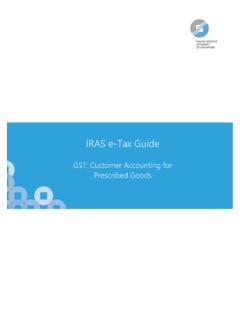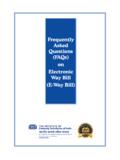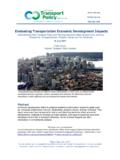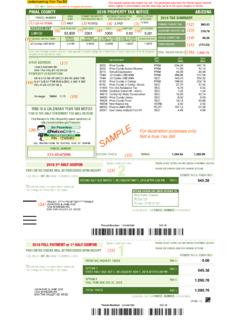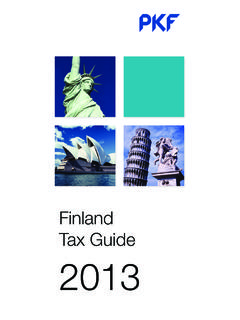Transcription of FRS 115 Revenue Recognition - EY - United States
1 FRS 115 RevenueRecognitionAre you prepared for the tax challenges of the new revenuerecognition standard?OverviewThe accounting requirements for recognising Revenue are changing. On 19 November 2014,the Accounting Standards Council issued Singapore Financial Reporting Standard (FRS) 115, Revenue from Contracts with Customers. This new Revenue Recognition standard is based onInternational Financial Reporting Standards (IFRS) 15 Revenue from Contracts withCustomers, a jointly issued converged standard on Revenue Recognition by the InternationalAccounting Standards Board and the Financial Accounting Standards 115 is effective for annual periods beginning on or after 1 January 2017.
2 Early adoptionof the new Revenue standard is , FRS 115 aims, amongst several objectives, to clarify the principles forrecognising Revenue that would remove inconsistencies and weaknesses in current revenuerequirements and provide a more robust framework for addressing Revenue core principle of FRS 115 is for entities to recognise Revenue to depict the transfer ofgoods or services to customers in amounts that reflect the consideration which the entityexpects to be entitled to in exchange for those promised goods or all industries will be affected by the new Revenue standard which applies to allcontracts that
3 An entity has with its customers that will give rise to Revenue in the entity (withlimited exceptions). Depending on the industry and current accounting requirementsapplicable to the industry, the impact of FRS 115 can be more significant for some 115 Tax AlertIssue 1 (19 March 2015)Section or Chapter titleAll Rights Reserved [Insert local EY firm Name]FRS 115 Tax Alert (March 2015)|1 The five-step model for revenuerecognitionThe key difference between FRS 115 and the existingrevenue Recognition standard, FRS 18 Revenue is theintroduction of the five-step model when an entityrecognises Revenue from a contract with a customer,namely.
4 Step1 Identify the contract(s) with a customer2 Identify the separate performance obligations inthe contract3 Determine the transaction price4 Allocate the transaction price to the separateperformance obligations5 Recognise Revenue when (or as) the entitysatisfies a performance obligationSee Annex for of obtaining contractsIn addition, the new Revenue standard also specifies howentities are to account for incremental costs of obtaining acontract and the costs directly related to fulfilling acontract. Generally, if these costs are expected to berecovered, they can be capitalised and subsequentlyamortised and tested for entities will be required to apply FRS 115retrospectively using either a full retrospective approach or a modified retrospective approach.
5 Entitiesthat elect the full retrospective approach will have toapply the new standard to all the periods presented in thefinancial statements in accordance with the existingaccounting standards. This will normally result in theentity making cumulative catch-up adjustments(retrospective adjustments) to the comparative periodspresented in the financial statements. Practicalexpedients are available in FRS 115 to provide relief toease the burden for entities who may wish to apply the full retrospective , entities may adopt the modifiedretrospective approach to reflect the impact of the newstandard.
6 Under this approach, the standard will only beapplied to the most current period presented in thefinancial statements. Entities will continue to presentcomparative periods in accordance with existing revenuestandards and recognise a retrospective adjustment to theopening balance of retained earnings at the effective datefor existing contracts that still require performance by theentity in the year of adoption. However, this approachrequires entities to disclose additional information in theirfinancial tax considerationsWith the adoption of the new Revenue standard, what arethe tax challenges that companies should be aware of andwhat can you do now?
7 (1) Revenue Recognition for tax purposes may not be thesameCompanies should not assume that the timing and amountof Revenue recognised under the new Revenue standardwill be the same for tax purposes. This assumption shouldbe the Revenue recognised under FRS 115 differs fromthe Revenue assessable for tax purposes, new significanttemporary differences may arise or existing temporarydifferences may need to be accounted for differently. Itwill also affect the income tax return filings of example, if the arrangement with the customerinvolves variable consideration, the new Revenue standardrequires the company to determine the variableconsideration to be included in the transaction price atcontract inception using a permitted a result, the company may recognise an amount ofsuch Revenue sooner.
8 If the variable consideration is onlyregarded as taxable in the future, this would result in adeferred tax impact in the financial may also need to revise their processes anddocumentation to capture the new temporary differencesfor tax reporting purposes in order to substantiate the taxadjustments upon request by the Inland RevenueAuthority of Singapore (IRAS).(2)Companies may miss out on opportunities of claiminga tax deduction on contract costs earlierContract costs under FRS 115 may differ from what theyare today as the new Revenue standard requirescapitalisation in certain circumstances.
9 In this scenario,companies should determine whether this will result in adifferent pattern of expense Recognition for financial andtax reporting example, the capitalised contract costs may be taxdeductible to the company in full when the costs areincurred instead of the amortised amount for or Chapter titleAll Rights Reserved [Insert local EY firm Name]FRS 115 Tax Alert (March 2015)|2(3)Uncertainty in income tax implications ofretrospective adjustmentAdoption of FRS 115 under the full retrospective or modified retrospective approach will likely result in aretrospective adjustment for accounting purposes.
10 Asthere can be a significant upward or downwardretrospective adjustment, companies should gain athorough understanding of the income tax implications ofthis adjustment. The questions that companies shouldconsider are: Would the IRAS permit the Retrospective Adjustmentfor tax purposes? In which financial period would the RetrospectiveAdjustment be allowed for tax purposes the financialyear(s) to which the adjustment relates to or thefinancial year of adoption of FRS 115? What would be the overall income tax impact to thecompany due to the revisions of income taxcomputations?












